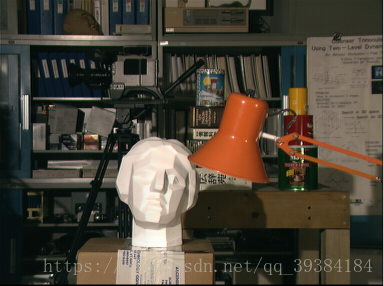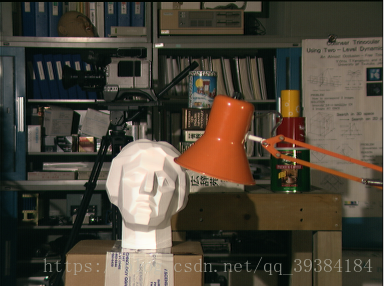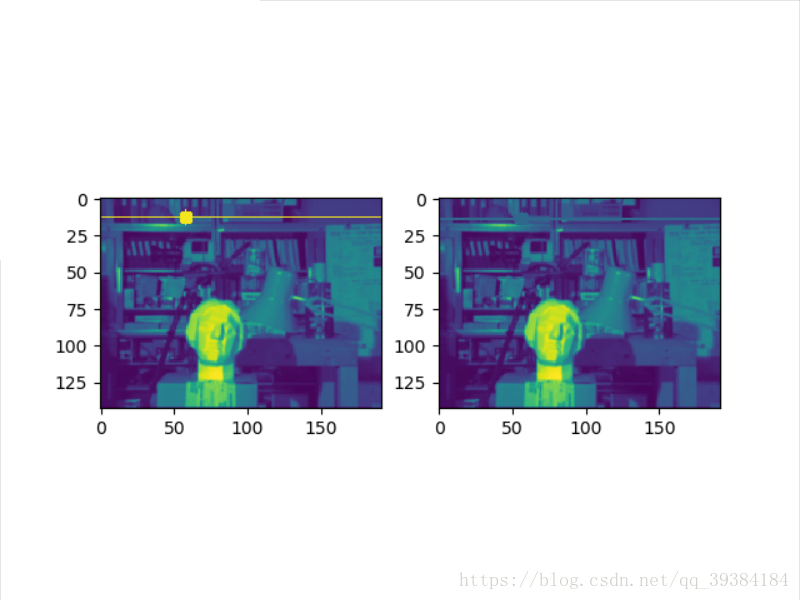使用深度摄像头可以在捕获图像时估计图像与摄像头之间的距离。但是对于普通摄像头,可以使用属于立体视觉(stereo vision)几何学的极几何(Epipolar Geometry)从同一物体的两张不同图像上提取三维信息。
如果运行失败(参见链接:关于OpenCV算法未实现及其版权问题)。
下面是一个例子:
# 从视差图得到图像深度
import cv2
import numpy as np
from matplotlib import pyplot as plt
def to_uint8(data):
# maximum pixel
latch = np.zeros_like(data)
latch[:] = 255
# minimum pixel
zeros = np.zeros_like(data)
# unrolled to illustrate steps
d = np.maximum(zeros, data)
d = np.minimum(latch, d)
# cast to uint8
return np.asarray(d, dtype="uint8")
def draw_lines(img1, img2, lines, pts1, pts2):
''' img1 - image on which we draw the epilines for the points in img2
lines - corresponding epilines '''
print
img1.shape
r, c, ch = img1.shape
clr1 = cv2.pyrDown(cv2.imread('stacked1.png', 0))
clr2 = cv2.pyrDown(cv2.imread('stacked2.png', 0))
for r, pt1, pt2 in zip(lines, pts1, pts2):
color = tuple(np.random.randint(0, 255, 3).tolist())
x0, y0 = map(int, [0, -r[2] / r[1]])
x1, y1 = map(int, [c, -(r[2] + r[0] * c) / r[1]])
clr1 = cv2.line(clr1, (x0, y0), (x1, y1), color, 1)
clr1 = cv2.circle(clr1, tuple(pt1), 5, color, -1)
clr2 = cv2.circle(clr2, tuple(pt2), 5, color, -1)
return clr1, clr2
img1 = to_uint8(cv2.pyrDown(cv2.imread('stacked1.png', cv2.COLOR_BGR2GRAY))) # queryimage # left image
img2 = to_uint8(cv2.pyrDown(cv2.imread('stacked2.png', cv2.COLOR_BGR2GRAY))) # trainimage # right image
sift = cv2.xfeatures2d.SIFT_create()
# find the keypoints and descriptors with SIFT
kp1, des1 = sift.detectAndCompute(img1, None)
kp2, des2 = sift.detectAndCompute(img2, None)
# FLANN parameters
FLANN_INDEX_KDTREE = 0
index_params = dict(algorithm=FLANN_INDEX_KDTREE, trees=5)
search_params = dict(checks=50)
flann = cv2.FlannBasedMatcher(index_params, search_params)
matches = flann.knnMatch(des1, des2, k=2)
good = []
pts1 = []
pts2 = []
# ratio test as per Lowe's paper
for i, (m, n) in enumerate(matches):
if m.distance < 0.8 * n.distance:
good.append(m)
pts2.append(kp2[m.trainIdx].pt)
pts1.append(kp1[m.queryIdx].pt)
pts1 = np.int32(pts1)
pts2 = np.int32(pts2)
F, mask = cv2.findFundamentalMat(pts1, pts2, cv2.FM_LMEDS)
# We select only inlier points
pts1 = pts1[mask.ravel() == 1]
pts2 = pts2[mask.ravel() == 1]
# Find epilines corresponding to points in right image (second image) and
# drawing its lines on left image
lines1 = cv2.computeCorrespondEpilines(pts2.reshape(-1, 1, 2), 2, F)
lines1 = lines1.reshape(-1, 3)
img5, img6 = draw_lines(img1, img2, lines1, pts1, pts2)
# Find epilines corresponding to points in left image (first image) and
# drawing its lines on right image
lines2 = cv2.computeCorrespondEpilines(pts1.reshape(-1, 1, 2), 1, F)
lines2 = lines2.reshape(-1, 3)
img3, img4 = draw_lines(img2, img1, lines2, pts2, pts1)
plt.subplot(121), plt.imshow(img5)
plt.subplot(122), plt.imshow(img3)
plt.show()
- stacked1.png

- stacked2.png

- 运行结果

最后
以上就是明理硬币最近收集整理的关于OpenCV——使用普通摄像头进行深度估计的全部内容,更多相关OpenCV——使用普通摄像头进行深度估计内容请搜索靠谱客的其他文章。
本图文内容来源于网友提供,作为学习参考使用,或来自网络收集整理,版权属于原作者所有。








发表评论 取消回复